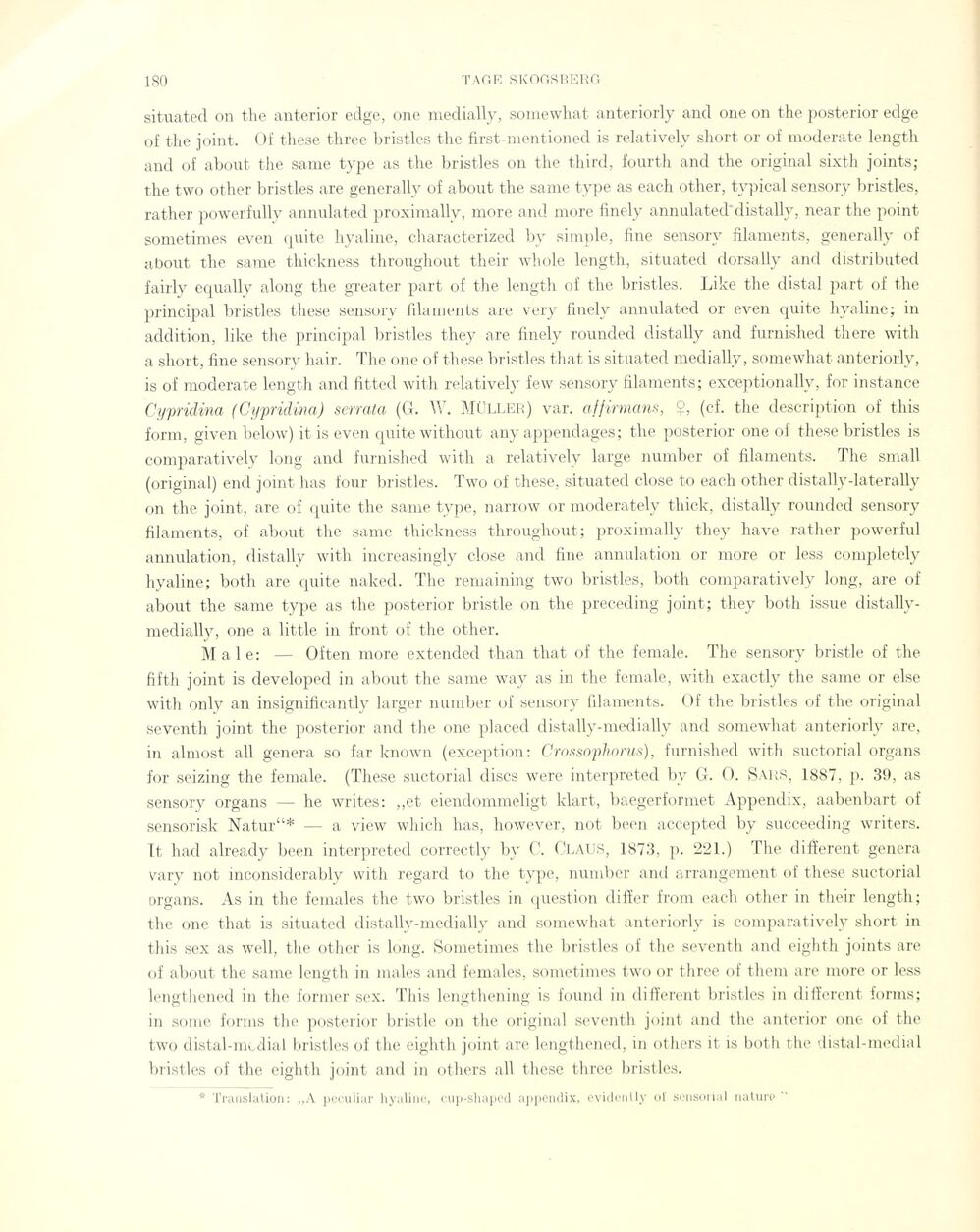
Full resolution (JPEG) - On this page / på denna sida - Sidor ...

<< prev. page << föreg. sida << >> nästa sida >> next page >>
Below is the raw OCR text
from the above scanned image.
Do you see an error? Proofread the page now!
Här nedan syns maskintolkade texten från faksimilbilden ovan.
Ser du något fel? Korrekturläs sidan nu!
This page has never been proofread. / Denna sida har aldrig korrekturlästs.
situated on the anterior edge, one medially, somewhat anteriorly and one on the posterior edge
of the joint. Of these three bristles the first-mentioned is relatively short or of moderate length
and of about the same type as the bristles on the third, fourth and the original sixth joints;
the two other bristles are generally of about the same type as each other, typical sensory bristles,
rather powerfully annulated proximallv, more and more finely annulated’distally, near the point
sometimes even quite hyaline, characterized by simple, fine sensory filaments, generally of
about the same thickness throughout their whole length, situated dorsally and distributed
fairly equally along the greater part of the length of the bristles. Like the distal part of the
principal bristles these sensory filaments are very finely annulated or even quite hyaline; in
addition, like the principal bristles they are finely rounded distally and furnished there with
a short, fine sensory hair. The one of these bristles that is situated medially, somewhat anteriorly,
is of moderate length and fitted with relatively few sensory filaments; exceptionally, for instance
Cypridina (Cypridina) serrata (G. AV. Müller) var. affirmans, $, (cf. the description of this
form, given below) it is even quite without any appendages; the posterior one of these bristles is
comparatively long and furnished with a relatively large number of filaments. The small
(original) end joint has four bristles. Two of these, situated close to each other distally-laterally
on the joint, are of quite the same type, narrow or moderately thiek, distally rounded sensory
filaments, of about the same thickness throughout; proximally they have rather powerful
annulation, distally with increasingly close and fine annulation or more or less completely
hyaline; both are quite naked. The remaining two bristles, both comparatively long, are of
about the same type as the posterior bristle on the preceding joint; they both issue
distally-medially, one a little in front of the other.
Male: — Often more extended than that of the female. The sensory bristle of the
fifth joint is developed in about the same way as in the female, with exactly the same or else
with only an insignificantly larger number of sensory filaments. Of the bristles of the original
seventh joint the posterior and the one placed distally-medially and somewhat anteriorly are,
in almost all genera so far known (exception: C r os sopho rus), furnished with suctorial organs
for seizing the female. (These suctorial discs were interpreted by G. O. Sars, 1887, p. 39, as
sensory organs — he writes: „et eiendommeligt klart, baegerformet Appendix, aabenbart of
sensorisk Natur“* -— a view which has, however, not been accepted by succeeding writers.
It had already been interpreted correctly by C. Claus, 1873, p. 221.) The different genera
Vary not inconsiderably with regard to the type, number and arrangement of these suctorial
organs. As in the females the two bristles in question differ from each other in their length;
the one that is situated distally-medially and somewhat anteriorly is comparatively short in
this sex as well, the other is long. Sometimes the bristles of the seventh and eighth joints are
of about the same length in males and females, sometimes two or three of thern are more or less
lengthened in the former sex. This lengthening is found in different bristles in different forms;
in some forms the posterior bristle on the original seventh joint and the anterior one of the
two distal-mcdial bristles of the eighth joint are lengthened, in others it is both the distal-medial
bristles of the eighth joint, and in others all these three bristles.
* Translation: „A peculiar hyaline, cup-shaped appendix, evidently of sensorial nature“
<< prev. page << föreg. sida << >> nästa sida >> next page >>